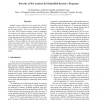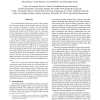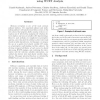365 search results - page 2 / 73 » Semi-automatic derivation of timing models for WCET analysis |
WCET
2008
13 years 6 months ago
2008
Conditional branches connect the values of program variables with the execution paths and thus with the execution times, including the worstcase execution time (WCET). Flow analys...
WORDS
2005
IEEE
13 years 11 months ago
2005
IEEE
Reliable program Worst-Case Execution Time (WCET) estimates are a key component when designing and verifying real-time systems. One way to derive such estimates is by static WCET ...
RTAS
2005
IEEE
13 years 11 months ago
2005
IEEE
Low-end embedded architectures, such as sensor nodes, have become popular in diverse fields, many of which impose real-time constraints. Currently, the Atmel Atmega processor fam...
DAC
2006
ACM
14 years 6 months ago
2006
ACM
Accurate estimation of the worst-case execution time (WCET) of a program is important for real-time embedded software. Static WCET estimation involves program path analysis and ar...
WCET
2007
13 years 6 months ago
2007
Memory corruption is one of the most common software failures. For sequential software and multitasking software with synchronized data accesses, it has been shown that program fa...



